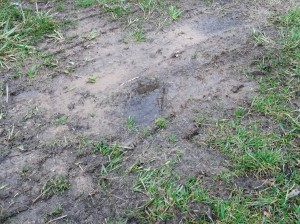Rainfall can be a good thing for a landscape. It is water, and plants need water. However, heavy rain can start to be a nuisance to the landscape after a while.
Heavy rains can erode loose soil. This can create ruts in a lawn or landscape. When the ruts are small, they will fill back in over time, but this may take some time to happen. If the ruts are large enough, they will need to be filled back in, and a solution needs to be created so that they do not happen again. This could be adding gutters to redirect the water, more plants to hold the soil in place better, or barriers or keep materials where they are wanted.
Heavy rains can also cause flooding. If the soil becomes saturated, the roots of your plants, including grass plants, will not be getting the air that they need. After a while, this can cause a decline in the health of the grass or landscape. This is the same reason why over-watering your lawn and landscape with your sprinkler system is not good. If your lawn or landscape is experiencing constant flooding, a drain may need to be installed to route the water somewhere else or a low spot may need to be raised.

Compacted soils and soils with large amounts of clay in them have a harder time draining water from their surface. When the soil is compacted, from heavy traffic for example, the soil structure is damaged. This makes it harder for water to drain from it. Clay is similar. The individual clay particles are so small that water has a hard time traveling around the individual particles, thus creating poor drainage. If your soil is compacted or clay, aerating will help to loosen the soil so the water can move into the soil.
With all of this being said, there is generally little reason for concern for your lawn and landscape unless you are having constant problems with rain, and your landscape is damaged every time that it rains. If this is the case, something needs to be done to correct the problems that you are having. Finding out where the water becomes a problem is the first step, and then deciding what steps need to be taken to stop it from happening again.